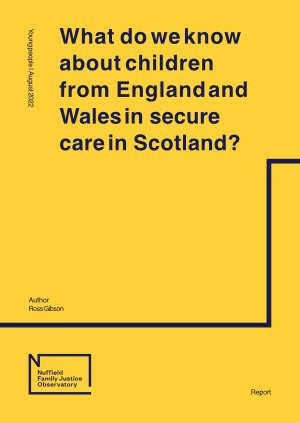By Ruby Whitelaw and Ross Gibson
Consideration of the role that secure care and Young Offenders Institutions (YOI) play in the lives of children deprived of their liberty has featured in both the Independent Care Review (2020) and the Scottish Ministers Programme for Government (2022). Both have indicated that there should be no under 18s held within a YOI by 2024, mandating instead that these children should be placed in “small, secure, safe, trauma informed environments that uphold the totality of their rights” (The Promise, 2020:91). This is likely to be reflected in the forthcoming Children (Care and Justice) (Scotland) Bill which will create the legislative changes to achieve this ambition. The Independent Care Review’s successor organisation, The Promise, has stated that it is time to “rethink the purpose, delivery and infrastructure of Secure Care, being absolutely clear that it is there to provide therapeutic, trauma informed support” (The Promise, 2020: 4). These developments are in keeping with the secure care strategic boards findings and recommendations (Secure Care Strategic Board, 2018). To inform the debate and discussion surrounding this task, the authors gathered information and evidence on the needs and circumstances of children who experience secure care or YOIs; we reviewed publicly available data and analysed a tranche of new, as yet unpublished, data gathered in recent secure care censuses. This has culminated in a report that can, we hope, inform the development of future provision for children who experience a deprivation of liberty due to the nature of their behaviour, or the risks they are exposed to. This report will consider whether, for all intents and purposes, the children placed within YOI are distinguishable from those entering secure care. The level of adversity experienced by both groups of children are considerably higher than within the general population, and broadly similar across both cohorts. Each face a range of complex and dynamic circumstances that are known to correlate with adverse outcomes over the short, medium and long term. Both cohorts of children have often demonstrated acts of significant harm, with secure care already providing care, support and supervision to children who have caused acts of grave and significant harm. There is considerable evidence that secure care and YOIs offer a wide array of resources, services, interventions, and programmes designed to meet the needs of the children within their care. The range of opportunities afforded provide an opportunity for services to learn from each other. However, the role of secure care and YOI must also be considered in light of the Scottish Parliament’s unanimous support for the incorporation of the United Nations Convention on the Rights of the Child, Article 1. This defines a child as anyone under the age of 18. Any changes to secure care or YOI provision are therefore a matter of children’s rights, and secure and custodial settings must strive to achieve the best possible outcomes for those in their care. This is particularly relevant given the Scottish Government has repeatedly committed to making Scotland the best place in the world for children to grow up (Scottish Government, 2022). Amongst other developments within academia, Scotland has benefited from longitudinal studies which have provided consistent and clear findings regarding the trajectory of those children who come into conflict with the law. The Edinburgh Study of Youth Transitions and Crime has repeatedly shown that involvement with formal judicial systems can adversely affect the process of desistance, and that most children who come into conflict with the law will end such behaviours by early adulthood according to McAra and McVie (2007, 2022). Findings from this long-running study have heavily influenced Scotland’s Whole System Approach; this calls on practitioners to utilise community alternatives to secure care and custody whenever possible, and to develop robust risk management strategies. These recent policy developments, the conclusions reached within The Promise and the earlier work done by stakeholders and partners combine to create a compelling portrait: the secure and child custodial estate must be seen through the prism of children’s rights. To assist colleagues across the children’s rights and justice landscape to best consider how to achieve these aims, CYCJ sought to gather information and evidence about secure care, and the use of YOIs for under 18s. We hope that this report can inform future developments in these services, promote the respective visions of The Promise and Scotland’s Youth Justice Strategy (2021) and contextualise the challenge set by The Promise. As we prepare to the end of the practice of holding children within YOIs, this report is designed to help key stakeholders to be ready for the next steps in secure care provision, including the development of alternatives to secure care. The Promise clearly sets out that prison is no place for Scotland’s children; to make that possible we require a clearer picture of their needs and the supports that are currently available. The report begins by setting out the purpose of secure care and shares previously unpublished data gathered as part of the secure care census in 2018 and 2019 (See Gibson, 2020, 2021, 2022). It outlines current provision within secure care and the demand for the service, whilst also exploring the approach taken to children and their families. It then discusses YOI provision - its purpose, function, and governance arrangements - as well as demand and approaches to children. Using data from the 2019 Scottish Prison Service prisoner surveys, the report illustrates the range of life experiences of children placed within YOIs.
Glasgow: Children and Young People's Centre for Justice, 2023. 39p.




















